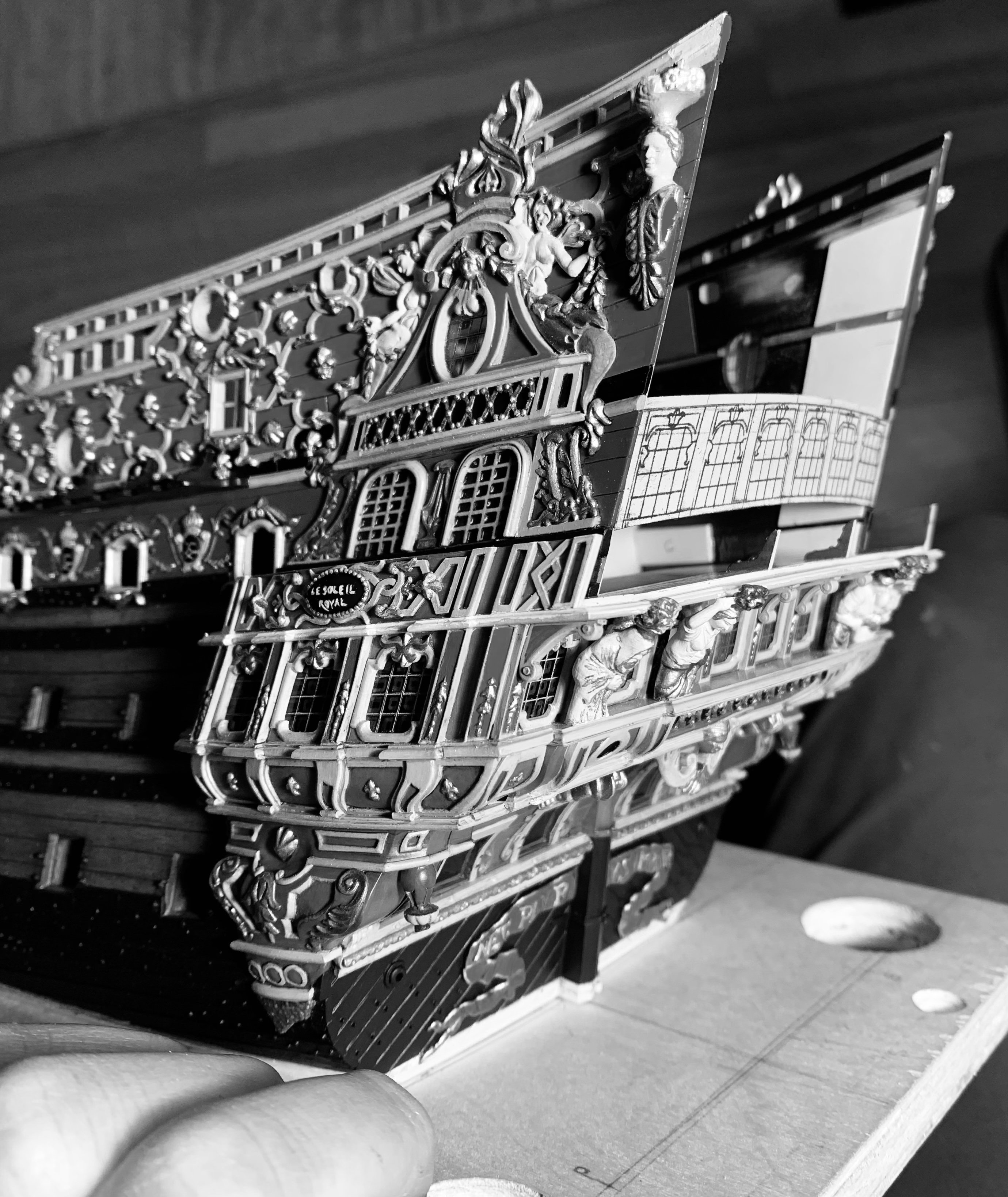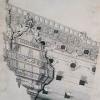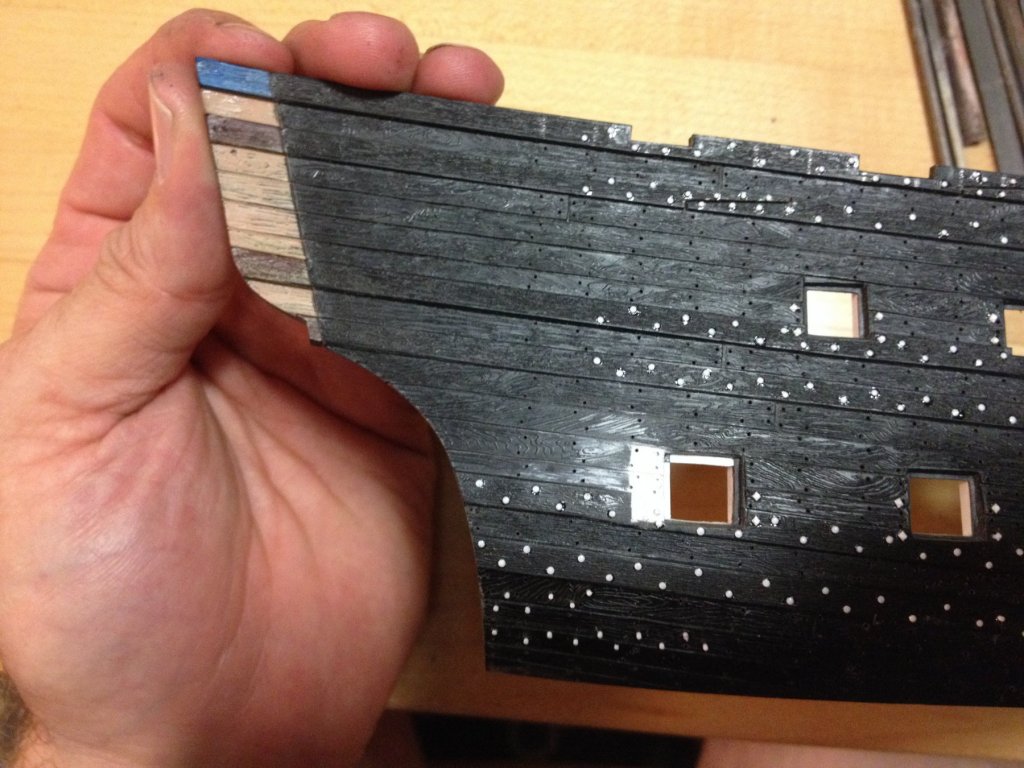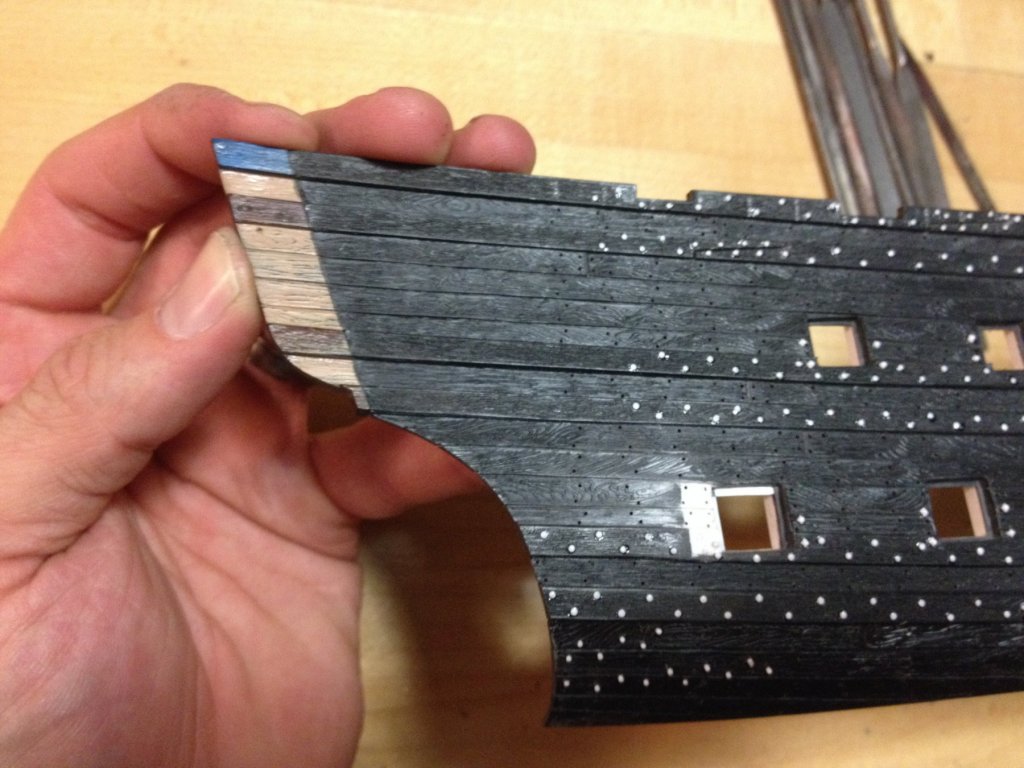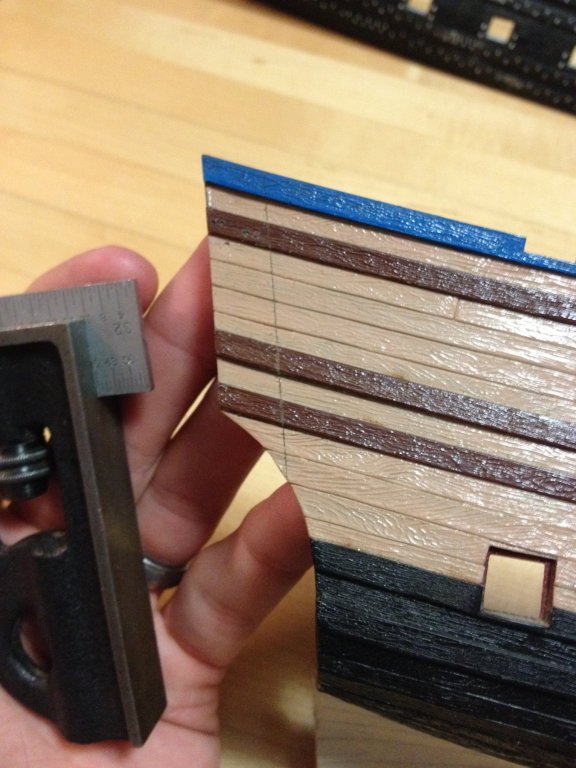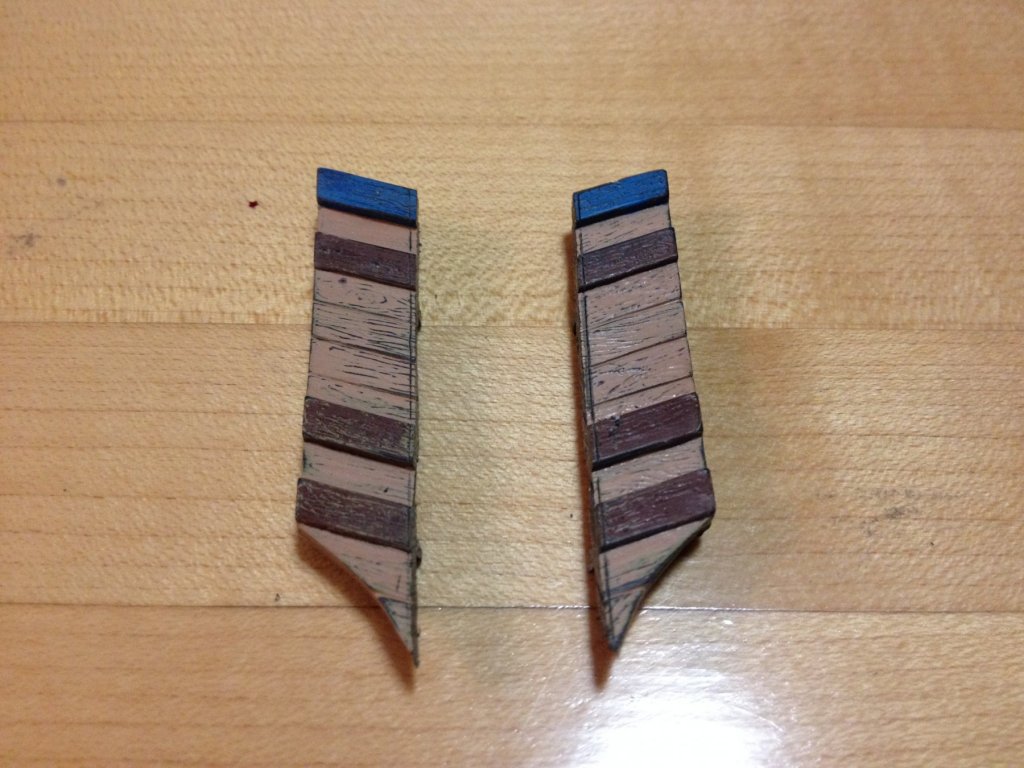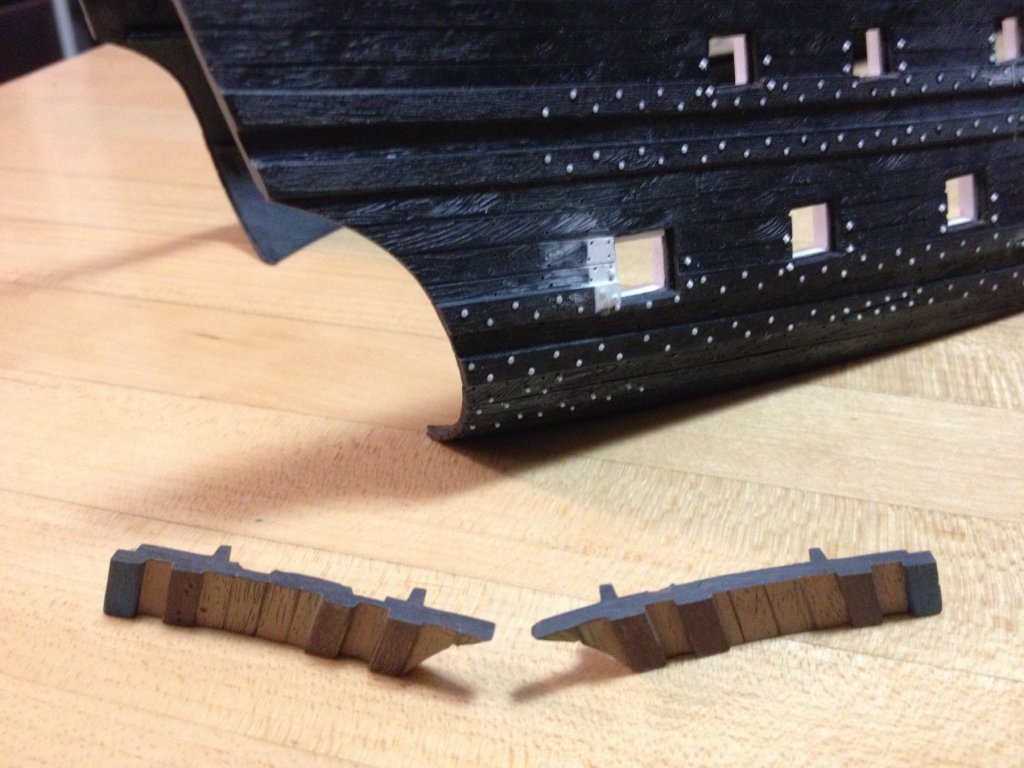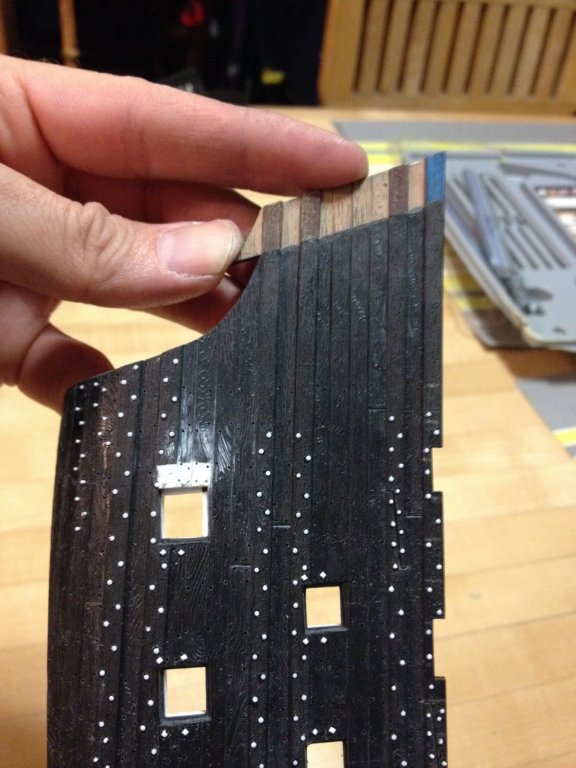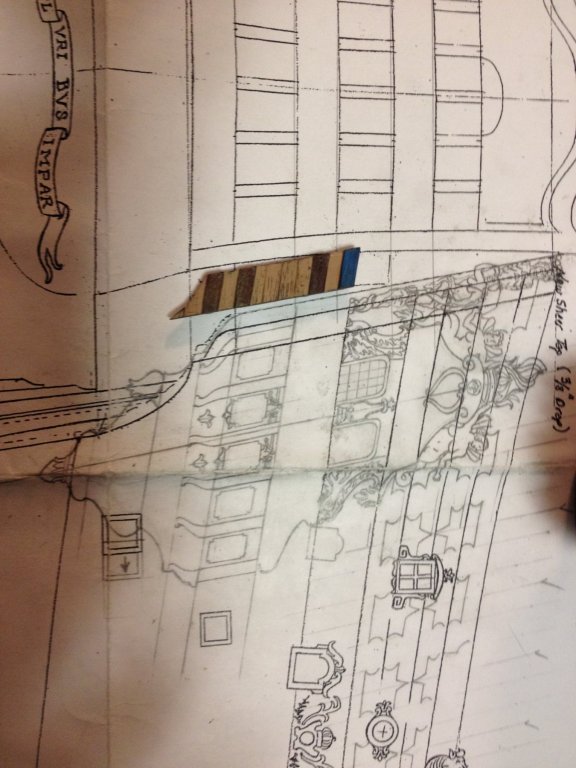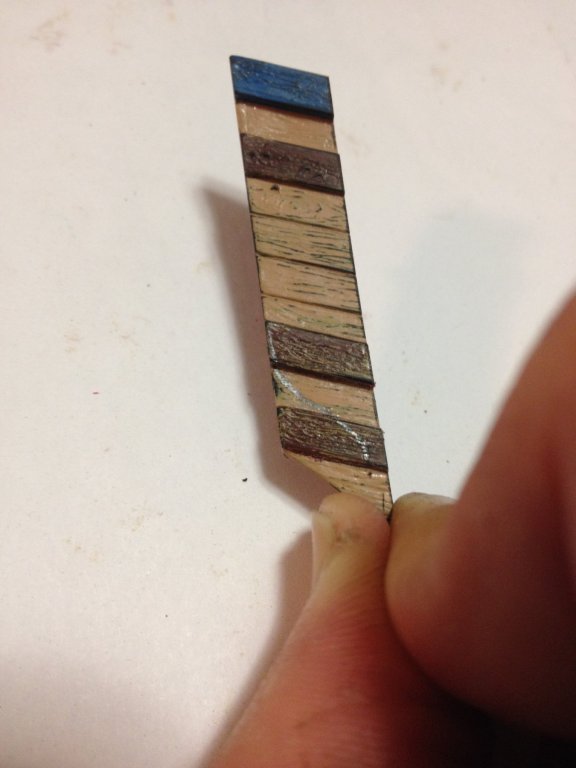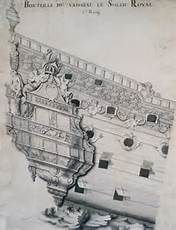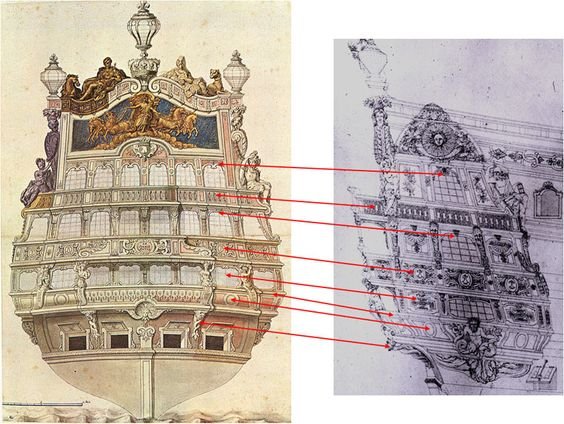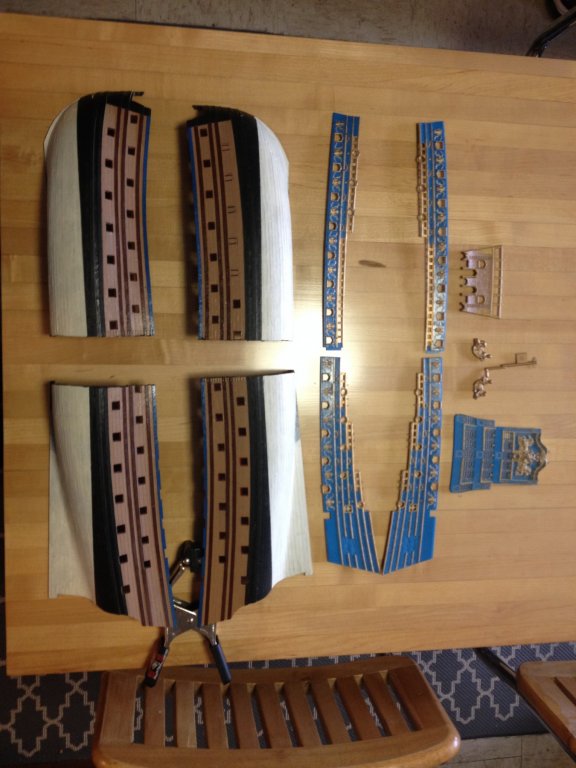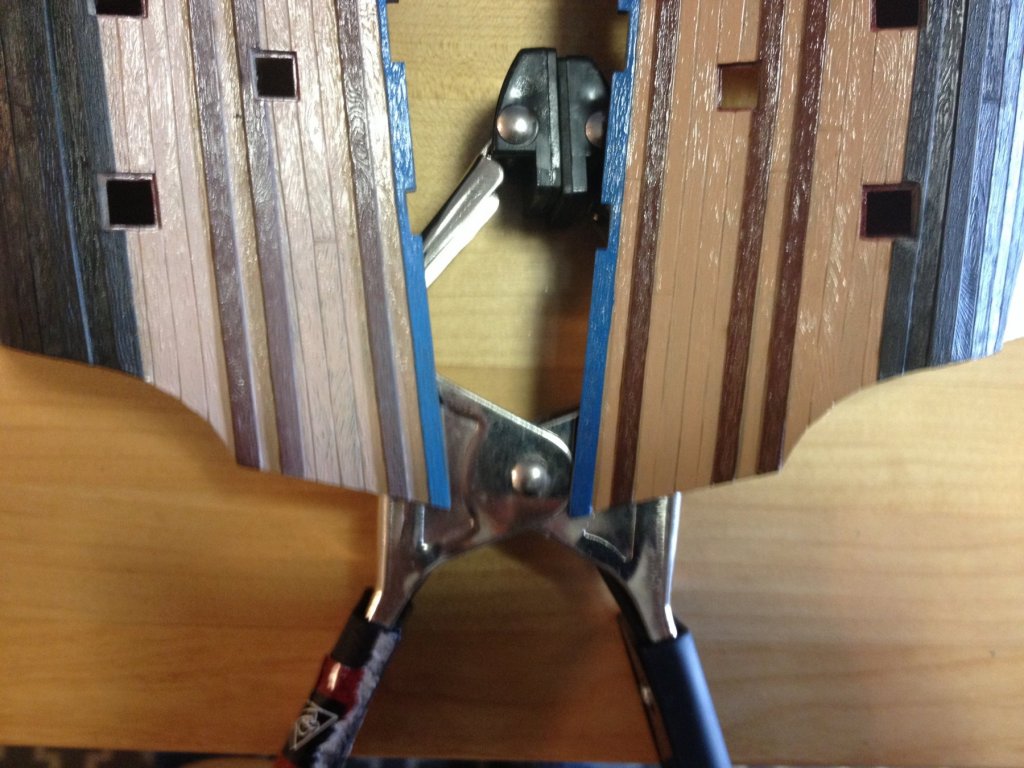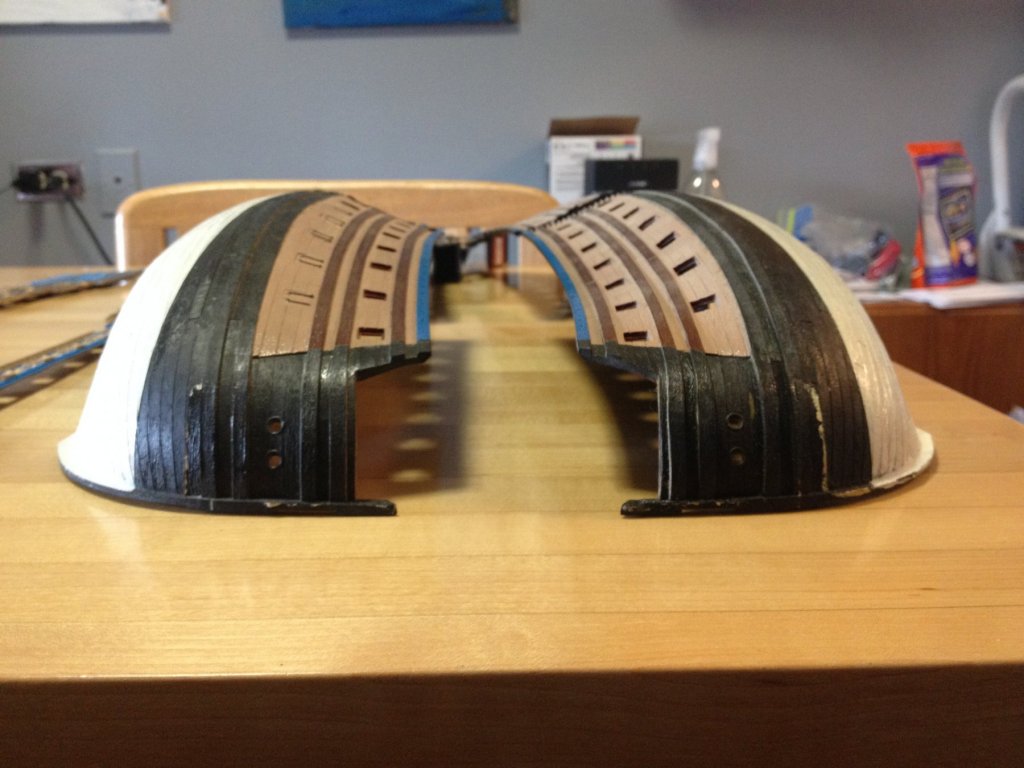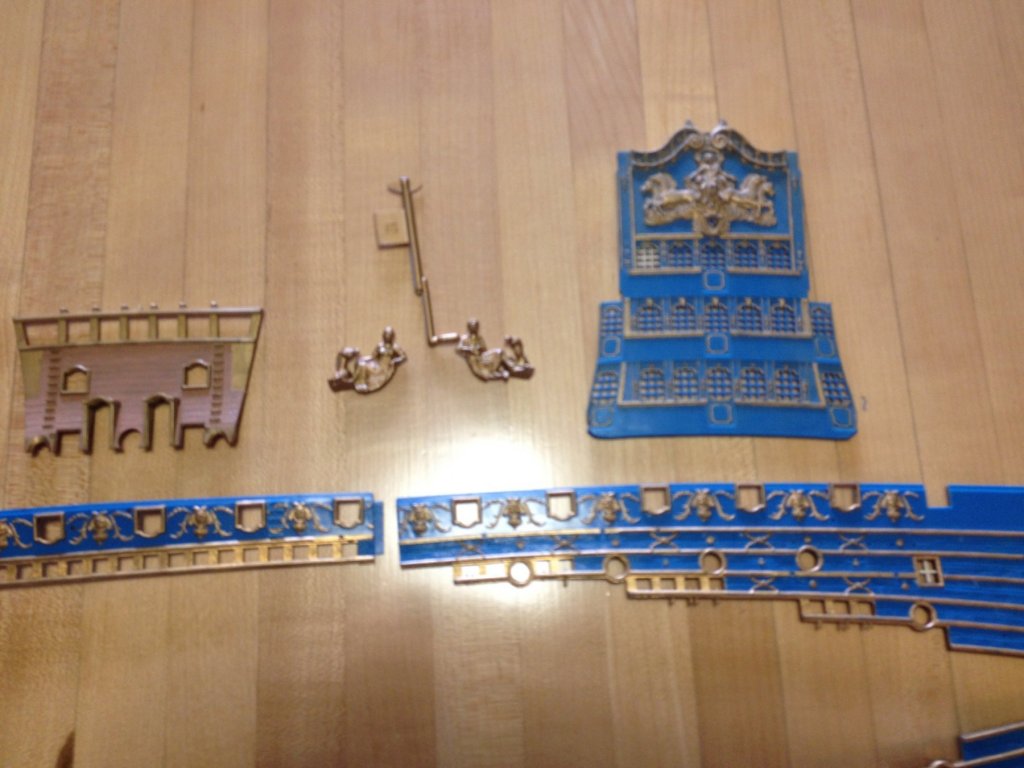-
Posts
3,292 -
Joined
-
Last visited
Content Type
Profiles
Forums
Gallery
Events
Everything posted by Hubac's Historian
-
Tonight, I managed to shape the upper stern counter profile into the starboard stern extension piece. It took a little doing, and a lot of checking back to my digital drawing, but I was finally satisfied with the shape. Before fixing it in place, I will thin the back edge and scribe in the plank butts, as I did for the lower transom. Once the pieces are glued, I will re-enforce the back of the joint with sheet styrene and epoxy.
- 2,696 replies
-
- heller
- soleil royal
-
(and 9 more)
Tagged with:
-
Having finally completed the drilling of the nail holes in the lower hull, I decided it was time to start tackling the first major modification of my kit-bash program. Rather than start with the widening of the bow, which presents a few tricky considerations, I thought I would first extend the stern by the 3/8" that I need to satisfactorily render Berain's quarter galleries, while simultaneously closing in the lower stern balcony, at the middle deck level. The first step was to true up the outboard edges of the hull, just above the counter. I did this on both the cut down hull that I am using, as well as the extra hull that Henry sent me: For the hull that I am using, it was essential to sand the edge straight and square because this will be the mounting surface for the extension piece. I applied the same care to Henry's hull, so that I could accurately mark out the 3/8" (+ an extra 1/64" for fitting loss) I needed with a try-square: Then, I used a really sharp coping saw to cut within a heavy 1/64" of my marked line. Here are the rough-cut blanks: Then, I sanded those faces to my line - offering up to the joint frequently, in order to be sure that the extension wasn't skewing inboard or outboard, but remaining true to the run of the hull. Here's a dry-fit extension piece: As I had hoped, the extension is short enough that the run of plank lines and wales remains continuous, without any tell-tale steps. Back here, it really won't matter as most of this will be completely covered by the quarter galleries, themselves, but this is encouraging for the bow. The repeat of moulded grain detail is negligable and hardly worth worrying about. The next step was to sketch in the new shape of the stern counter (which, previously would be an open, wrapping stern balcony on the stock kit). The reverse curve, here, is so subtle that it is difficult to draw on the uneven surface with any fidelity: Experience tells me, though, that I will have better success "drawing" with the tools. The pencil line, here, is merely a guide. I have decided, though, that I am too tired to give it the full focus that profiling requires, so I will postpone cutting these shapes until another night. The Dremel is out of juice, anyway.
- 2,696 replies
-
- heller
- soleil royal
-
(and 9 more)
Tagged with:
-
Thanks, Michel! The first two pages that I have read, so far, are certainly enlightenning.
- 2,696 replies
-
- heller
- soleil royal
-
(and 9 more)
Tagged with:
-
The lines are so true and the curves are so fair. This truly is a masterwork. When I consider that this is your first scratch-build - and your first forray into woodworking - I just scratch my head at the wonder of it! But Marc, you tease us with just the smallest glimpse of the poster on the wall above SR. This is a new addition to the workshop decor? Please show us the poster. And, yes, some day I will make it back to France. We had hoped - my sister and I - to bring my father back for one last visit on his 83rd birhday, his past summer. This isn't a sad story. My father is still alive and well. It was just the cost that was prohibitive. My children are also young, and once the school year begins, our finances go south 😔. But some day, I will get back there, and I will be all too happy to finally meet you and Michel. P.S. I am very impressed with your framing of the octagonal ports.
- 208 replies
-
- le soleil royal
- 104 guns
-
(and 2 more)
Tagged with:
-
I would love to meet up, sometime, Bill. As are you, I am learning quite a lot from our French contributors, as well as the rest of the MSW community, and am very happy to have so many avid enthusiasts of the ship, talking about her in one space, in multiple excellent build logs. I will send you a PM.
- 2,696 replies
-
- heller
- soleil royal
-
(and 9 more)
Tagged with:
-
Michel, do you have this document in it's original form? Sometimes the translators make a jumble of it. I might have more success translating it directly. Or is this included in the same PDF document that Cedric just referenced, in which case I will find the passage eventually.
- 2,696 replies
-
- heller
- soleil royal
-
(and 9 more)
Tagged with:
-
The end product looks crisp and clean, Dan, but WOW - what a journey! I'm glad it all worked out so well. 'Had to laugh about your political commentary.
- 287 replies
-
- michelangelo
- ocean liner
-
(and 1 more)
Tagged with:
-
I have read the Vichot letter, and it is just exactly as Michel has explained. The letter resurrects an older question for me: the original decor of 1669 was initially designed by Peter Puget, and later refined by Jean Berain in 1668/69 for the refit. Do Puget's drafts for the original decor still exist in any way shape or form? At the Louvre, Brest or Toulon, maybe?
- 2,696 replies
-
- heller
- soleil royal
-
(and 9 more)
Tagged with:
-
Michel, I do not feel slighted in the work that I have done, but I know well that you can't look past the inherent flaws in the kit. Some of these flaws have been addressed, so far, and many others will be modified as I go. While now, in large part thanks to you, I know the difference between what the Heller kit is and what it should be - my experiments, here, are purely for the fun in making and to see what is or isn't possible with a plastic kit. The end result, I promise you, will be a much better facsimile of a French first-rate from the latter half of the 17th C. However, by the very nature of the build, it won't be the perfect picture. Just a better picture. Dramatically better, even. Thank you for this letter from Commander Vichot. I will have to translate this later, on my home computer, where I can tile screens and transcribe directly into Google Translate.
- 2,696 replies
-
- heller
- soleil royal
-
(and 9 more)
Tagged with:
-
I believe that the correct interpretation of the Berain drawing, that is my avatar, would be a closed middle deck level of the quarter gallery; an open walk that wraps to the stern at the main deck level of the QG; and a shallow amortissement at the quarter deck level of the QG. The Berain design of the QG (my avatar), however, is quite a different animal than the one portrayed on the Tanneron model, which as you mentioned before Bill, likely represents the second SR of 1693. There is another Berain schematic for the QGs (which agrees very closely, from side view to stern view with the known Berain drawing of the stern) from which I believe that Tanneron derived his concept of the ship from, and which in my opinion, represents a likely refinement (and a paring down) of many of the same motifs from the re-fit of 1689 into the re-construction of 1693. photo credit: Michel Saunier It is known that when Foudroyant of 1693 was re-named Soleil Royal in the midst of her construction, her ornamental scheme was also re-done to reflect the glory of the previous ship. This is merely my opinion, however, I am fairly certain that the above stern drawing dates to 1689, and corresponds very closely with the first QG (as I have described in detail, earlier in this build log). This same ornamental scheme for the stern was very likely recreated for the second SR of 1693 because it is truly a masterpiece of design. Again, this is my educated guess based on the undeniable agreement between the stern and the second QG. The second QG drawing does not exactly mirror the Tanneron model, however, there are striking similarities, nonetheless. This second QG design (IMO) appears to reflect the progressively more austere approach to ornamentation that begins in the late 17th century until it's disappearance altogether in the 19th century. I am probably wrong, but this is what I think to be the case. As to the question of whether the QGs had open walks, throughout, this seems to have been a feature of ships from the First Marine of Colbert, of which, the pre-re-fit Soleil Royal would likely have possessed, but not the Second Marine ships from 1693 onward. As there are no reliable representations of the ship, prior to 1689 (again, my whole theory revolves around my belief that the first QG represents the re-fit decor), it is un-known what she really looked like in her very first incarnation.
- 2,696 replies
-
- heller
- soleil royal
-
(and 9 more)
Tagged with:
-
Thank you, Bill. You are correct that the Tanneron model is of the second SR, ex Foudroyant. The issue you raise about the sheer of the lower wales, particularly at the bow (where they rise too sharply) is one that I do not feel is worth the effort to correct on the Heller kit. In a full scratch build, of course, one would be free to correctly lay out the gun decks, the port openings and the position of the wales, relative to the waterline - as have NekO and Michel. With this sort of thing, though, one does have to draw the line somewhere. I appreciate that you are enjoying the build, Bill .
- 2,696 replies
-
- heller
- soleil royal
-
(and 9 more)
Tagged with:
-
Thank you Michel. I appreciate where you are coming from, however, I have discussed at length why I am doing what I am doing with this kit, so I won't continue to justify it. Follow along, if you like, or not. It is, of course, optional.
- 2,696 replies
-
- heller
- soleil royal
-
(and 9 more)
Tagged with:
-
Earlier this week, I received a box of spare parts from Henry (Popeye2sea) from an earlier attempt to model the ship. Despite his excellent paint work, Henry found that he couldn't overcome the badly warped section of the port bow. So, he eventually started from scratch with a new kit and is in the midst of an excellent and highly detailed build-log, of which a number of you are already familiar. Henry sent me more parts than these, but these are the primary components with which I will perform some of the more substantive modifications of my build. Henry quartered the hull for the sake of easier shipping, which is fine with me because I only really need small sections of the lower hull, at the bow and stern, in order to broaden and extend my hull. O Above, you can see the extreme warping of the port bow. The boxed model must have come in contact with intense, direct heat at some point before Henry bought it. The upper bulwark pieces will provide me with all of the arched main deck port openings that I need, in order to straighten the run of these ports on my model, as well as the 3/8" extension I need at the stern. The stern plate enables me to broaden the stern and include the missing sixth stern window of the Berain design, without having to build all of the window opennings from scratch, or cast extras from my existing stern plate. Likewise, the beakhead bulkhead should enable me to broaden the bow. And the tafferal figures of Europe and Asia may be useful for lengthening the ones I have so that I don't have to model these figures from scratch. All in all, these parts represent an enormous time savings and I am extremely grateful to Henry for making this happen!
- 2,696 replies
-
- heller
- soleil royal
-
(and 9 more)
Tagged with:
-
Tremendous progress, Vic. The masting and rig look spectacular. I can't wait to see her on the water!
- 213 replies
-
- la couronne
- 74 gun
-
(and 2 more)
Tagged with:
-
Thanks, MD! Well, this sounds like essential reading for anyone that wants to more fully understand these ships for the machinery they were. I have one Hocker book on the Vasa - a bit more of a general overview of all the topics he expounds upon in these two volumes. Maybe one day, when I'm feeling a little wealthy, I'll invest in volume I. It is heartening that the people at the Vasa museum have done so much to try and understand the full import of the Vasa as an archeological find.
-
I am quietly enjoying this excellent build-log, and I am hoping that you guys can enlighten me on something that I've seen mentioned a few times here: What is, or what will be Vasa II? A new kit? A full-size replica project with appropriate draft and beam, in order to actually sail? Whatever it is, it sounds interesting.
-
Thank you, Cedric! So far, I'm only two thirds of the way through one hull half, and that doesn't include the upper bulwarks. I could project the math and figure out, roughly, how many holes there are a side, however, I don't have the thing in front of me, right now. My guestimate would be somewhere in-between 2,000-2,500 per hull half. The upper bulwarks will add considerably to that. Maybe somewhere in the range of 8,000 holes when all is said and done. It's okay, time is still on my side. Either today or tomorrow, the spare parts that Henry (Popeye2Sea) has so generously donated to my experimental hull expansion project - "Le Franken-Royal" - should arrive. The hull parts he is sending me were too badly warped to make a model from, but the small bits I need for the bow and stern should be perfectly useable. I'll use what's left to work up paint samples. I really want to see what impact different primer colors (flat black, primer grey, flat white) have on this color Ventre de Biche. When are you sending me updates, Cedric?
- 2,696 replies
-
- heller
- soleil royal
-
(and 9 more)
Tagged with:
-
I was kind of hoping you would disappoint me - even just a little bit - so I could feel a little better about my relative talents and abilities 😉. You know - maybe, a slightly open seam, or worse - the use of off-color putty as filler, or maybe an errant fastenner or two. Maybe a weird dip or bump in the hull. But nothing. Nope. Nada. Zip! Just a seamless work of utterly awesome perfection 👏👏!! Marc, I can see a little better the arc of your sheerline, in these pictures, and I think that it looks really very good. Maybe it could drop a liiiiiittle more, but it is not as straight seeming as I thought before. It's just a problem of perspective, where none of these pictures focuses on the rise of the sheer, so it is difficult to perceive. One little bit of fun, is to use the screen margin of my phone, to scroll down (on several pics) so that the ship appears to sit on her waterline. The figure she cuts in this view is absolutely a convincing portrait of a 17th Century first-rate ship. Even without all of the ornamental embellishments, one can see where this is headed. And that is not to minimize the form of the lively works, which display perfect symetry and a sense of draft befitting of such a heavily armed ship. BRAVO, Marc!!
- 208 replies
-
- le soleil royal
- 104 guns
-
(and 2 more)
Tagged with:
-
Well, I might have to give that a try. The Testers liquid cement doesn't bother me much, but I do ventilate pretty aggressively. Would be good to have a backup option.
- 961 replies
About us
Modelshipworld - Advancing Ship Modeling through Research
SSL Secured
Your security is important for us so this Website is SSL-Secured
NRG Mailing Address
Nautical Research Guild
237 South Lincoln Street
Westmont IL, 60559-1917
Model Ship World ® and the MSW logo are Registered Trademarks, and belong to the Nautical Research Guild (United States Patent and Trademark Office: No. 6,929,264 & No. 6,929,274, registered Dec. 20, 2022)
Helpful Links
About the NRG
If you enjoy building ship models that are historically accurate as well as beautiful, then The Nautical Research Guild (NRG) is just right for you.
The Guild is a non-profit educational organization whose mission is to “Advance Ship Modeling Through Research”. We provide support to our members in their efforts to raise the quality of their model ships.
The Nautical Research Guild has published our world-renowned quarterly magazine, The Nautical Research Journal, since 1955. The pages of the Journal are full of articles by accomplished ship modelers who show you how they create those exquisite details on their models, and by maritime historians who show you the correct details to build. The Journal is available in both print and digital editions. Go to the NRG web site (www.thenrg.org) to download a complimentary digital copy of the Journal. The NRG also publishes plan sets, books and compilations of back issues of the Journal and the former Ships in Scale and Model Ship Builder magazines.

